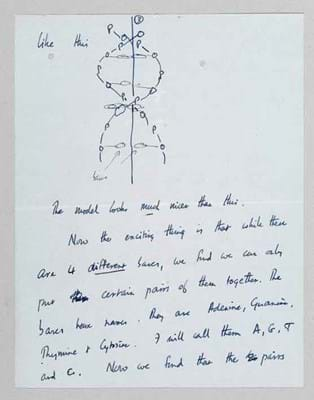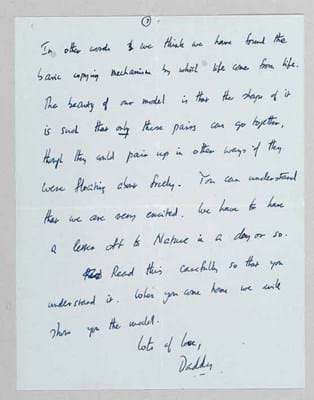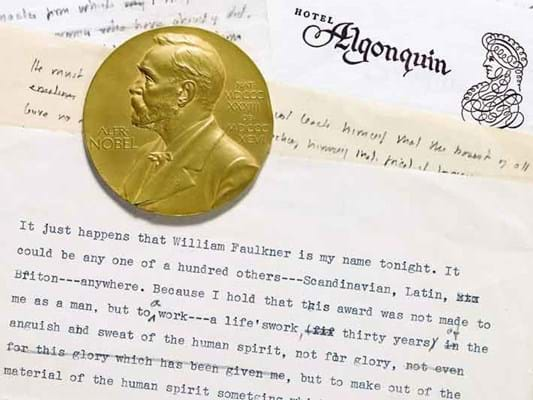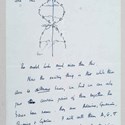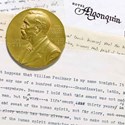But rather than revealing all to fellow eminent scientists, or the world's press perhaps, his signature at the bottom - 'daddy' - gives a clue to the recipient.
Dr Crick sent the seven-page letter to his son Michael who was at boarding school at the time, outlining the breakthrough. It sold at Christie's New York on April 10 for $5.3m (£3.5m), shattering the $1m-2m estimate.
The March 19, 1953, letter - bought by an anonymous phone bidder - told the 12-year-old in blue ink on pale blue paper how Dr Crick and James Watson had found the copying mechanism "by which life comes from life", complete with a simple diagram of DNA's double helix structure, which he admitted was not drawn very well.
Christie's sale sets a new world auction record for a letter, beating the $3m (then £1.6m) for an 1864 Abraham Lincoln letter sold at Sotheby's New York in April 2008. To Mary Tyler Peabody Mann, it was Lincoln's response to the "Children's Petition to the President asking him to free all the little slave children in this country", signed by 195 boys and girls under the age of 18.
A 1939 Albert Einstein letter to President Roosevelt, informing him of recent experiments by Fermi and Szilard, the possibility of using chain reactions for construction of bombs, and discussing availability and quality of uranium, made $1.9m (then £1.32m) at Christie's New York in March 2002.
The buyer's premium at Christie's New York was 25/20/12%.
Nobel Prize
Dr Crick - along with fellow doctors Watson and Maurice Wilkins - was awarded the Nobel Prize for Physiology or Medicine in 1962, and his medal was also sold on April 11 at Dallas-based Heritage Auctions (19% buyer's premium)for $1.9m (£1.26m) against an estimate of $500,000.
Heritage said the Nobel Prize medal had been kept in a safety deposit box in California since Dr Crick's widow passed away, and was one of ten lots consigned to auction by his heirs. The Christie's letter was also consigned by family.
Nobel Prize medal sales are very rare but this is actually the second one to be offered in the past six months. Danish physicist Aage Niels Bohr's 1975 Nobel Prize for Physics sold for about €37,500 (£30,240) last November at Bruun Rasmussen of Denmark, albeit below estimate.
A gold medal for the first Nobel Peace Prize awarded to an Englishman - Sir William Randal Cremer, an early union leader, MP and founder of several peace organisations - in 1903 sold for a premium-inclusive £11,550 ($17,441) at Sotheby's in November 1985.
William Faulkner's 1950 Nobel Prize for literature will be sold by Sotheby's New York in June along with a handwritten draft of his acceptance speech and diploma (in one lot, estimate in excess of $500,000). Faulkner started the draft while staying at the Algonquin Hotel in New York en route to the ceremony in Oslo and it is written on the hotel's letterhead. The Faulkner items have been consigned by his heirs.
Both Dr Crick's medal and letter will be supporting medical science. The medal sold to Jack Wang, chief executive of Biomobie, a biomedical firm in Shanghai, who had flown in for the auction. He said: "Dr Crick's Nobel Prize medal and diploma will be used to encourage scientists unravelling the mysteries of the Bioboosti, a bio-electrical signal that may control and enable the regeneration of damaged human organs."
Half the proceeds of the Christie's sale will benefit the Salk Institute for Biological Studies in La Jolla, California (where Dr Crick spent the last years of his career doing brain research), and about 20% of the proceeds from the Heritage sale will go to the new Francis Crick Institute, a research facility set to open in London in 2015.

